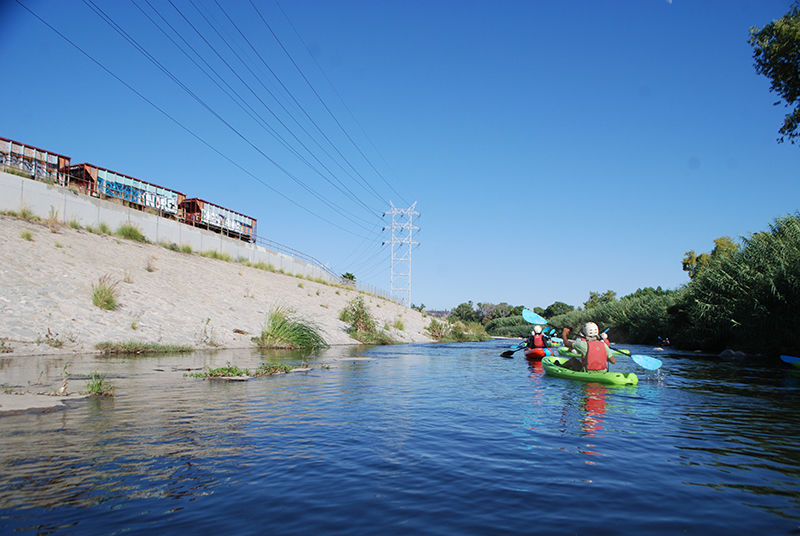Many years ago I took a guided tour of the Los Angeles River, which runs from Canoga Park to Long Beach. At the time, the river cut a mostly unseen, mostly unremarked upon, largely under-utilized 52-mile swath through the city. At the time, the response to the mention of such a tour was likely to be, “L.A. has a river?”
All that has changed. As the website for the L.A. River Center and Gardens explains, “The Los Angeles River Center and Gardens is located at the former site of the Lawry’s California Center, near the confluence of the L.A. River and the Arroyo Seco, close to Elysian Park and downtown Los Angeles. Its beautiful mission-style grounds and conference facilities serve as a focal point for the renewal of the L.A. River, and a prime location for community gatherings, educational conferences and special events.”
In fact, perhaps nothing illustrates the extent of the change more than the fact that the L.A. River Center seems to be soliciting clients to hold their weddings there.
For a more down-home, grass-roots activist approach, check out the Friends of the L.A. River (FoLAR), an organization founded over three decades ago by poet Lewis MacAdams.
FoLAR spearheads all manner of community-building activities, including: annual CleanUp days, FrogSpot, a weekend outdoor café; opportunities to give tours, kayak, and learn about the local habitat; and politically lobby to preserve the river for pedestrians, bikers, picnickers, free spirits and nature-lovers of all stripes.
Last year the L.A. River Revitalization Corp., a nonprofit group founded by the city in 2009, announced that it had hired 86-year-old mega-architect Frank Gehry to design an overarching new plan for the river. FoLAR, as can be imagined, was not pleased.
But in a recent interview with Martin C. Pedersen (posted Feb. 5 on the FoLAR website), MacAdams emphasized that the significance, the reach and the poetry of the 52-mile-long urbane river go far beyond any single design.
“We’re in the process of putting together a research project determining how much water the river needs. … We have three people … all young and ambitious. It’s a kind of an activist think tank. In the months to come, we’ll start issuing findings. The question — how much water does the river need? — can be looked at as the question for the whole river. It’s central to what we’ll be doing over the next year, rather than fret about Frank Gehry. It touches on all the issues, in terms of hydraulics, economics, culture, spiritual growth, the whole realm of things.
“There are a lot of questions to look at: is the L.A. River a natural river? If it were truly a natural river, it would only have water during the rainy season. But we have all this recycled water, which may end up being all the water we get. No one can truly predict that. The role of the river, how it maintains and encourages the ecology of the region, are fundamental questions that are only now beginning to be asked.”
That’s community-building, science and blood-sweat-and-tears dedication all rolled into one.
I kept telling myself I was going to re-visit the river, but since that long-ago tour, for whatever reason I hadn’t.
Then one recent afternoon, a friend who walks along the river frequently said, “Let’s go!” So we did, and I couldn’t believe the lushness, the magic! The sun was shining, a breeze riffled the water, and all around were birds! Cormorants, egrets, mallard ducks, great blue herons. Floating, soaring, cawing, perching on rocks, skimming over the water. In the water itself, we saw little red crayfish, like miniature lobsters, with spotted claws, schools of small black darting fish, and many half-submerged mud-covered golf balls from the nearby Los Feliz 3 Par Golf Course.
We poked sticks into the shallows, jumped over puddles and marveled over the flight of the great blues.
Just as we were almost back to our starting point we came upon a little man who was feeding a giant flock of pigeons. Their sleek purple-green heads, pecking for crumbs, formed a kind of thrillingly iridescent sea.
Whether we startled the birds or the man gave a sign — or St. Francis himself chose the moment to bestow a blessing — as if with one mind the pigeons suddenly rose, and, with a sedate flapping of wings, wheeled left, up, around and back, narrowly missing our heads, and settled down again.
Then, for good measure, they wheeled around the same way once more. To watch the birds, as if with one mind, perform their maneuvers in unison took my breath away. Simultaneously regimental and balletic, they emblemized a kind of unified theory of beauty that the human mind can never fully plumb.
Later, I thought how being down by the river was like being in two places at once:
In the city, with the traffic roaring by above, and in the wilderness, down below with the grebes.
On earth, with plastic bags snagged on the reeds, and in heaven, where birds fly free.
In time, where every afternoon eventually ends, and, in eternity, where we walk —let us hope — forever with a friend.
I went back the next night, alone: vespers with the herons.
Heather King is a blogger, speaker and the author of several books.

